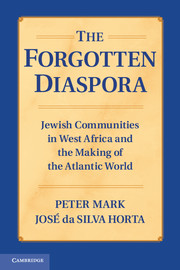Book contents
- Frontmatter
- Contents
- List of Illustrations
- Acknowledgments
- Introduction
- 1 Two Sephardic Communities on Senegal's Petite Côte
- 2 Jewish Identity in Senegambia
- 3 Religious Interaction
- 4 The Blade Weapons Trade in Seventeenth-Century West Africa
- 5 The Luso-African Ivories as Historical Source for the Weapons Trade and for the Jewish Presence in Guinea of Cape Verde
- 6 The Later Years
- Conclusion
- Appendix I The Jewish Traders of Porto d'Ale and Joal, Their Relatives, and Some of Their New Christian Partners in Senegambia and in the United Provinces and Portugal: A Comprehensive List (ca. 1606–ca. 1635)
- Appendix II A Chronological Outline of the Institutional Proceedings against the Jews of Porto d'Ale and Joal (1611–1643)
- Bibliography
- Index
- References
2 - Jewish Identity in Senegambia
Published online by Cambridge University Press: 03 May 2011
- Frontmatter
- Contents
- List of Illustrations
- Acknowledgments
- Introduction
- 1 Two Sephardic Communities on Senegal's Petite Côte
- 2 Jewish Identity in Senegambia
- 3 Religious Interaction
- 4 The Blade Weapons Trade in Seventeenth-Century West Africa
- 5 The Luso-African Ivories as Historical Source for the Weapons Trade and for the Jewish Presence in Guinea of Cape Verde
- 6 The Later Years
- Conclusion
- Appendix I The Jewish Traders of Porto d'Ale and Joal, Their Relatives, and Some of Their New Christian Partners in Senegambia and in the United Provinces and Portugal: A Comprehensive List (ca. 1606–ca. 1635)
- Appendix II A Chronological Outline of the Institutional Proceedings against the Jews of Porto d'Ale and Joal (1611–1643)
- Bibliography
- Index
- References
Summary
Identity in Senegambia
Identity in sixteenth- and seventeenth-century Senegambia was remarkably fluid. Individuals, as we have both argued elsewhere, often held multiple identities. These identities could be sequential, but they tended to be contextually contingent. This was true of the members of local African societies, but also of the Eurafrican descendents of unions between African women and European traders who had settled for varied lengths of time along the coast. Contextually determined and potentially multiple identities characterized the Luso-African offspring of the lançados (emigrants from Portugal and the Cape Verde Islands, including many New Christians, who had settled on the coast and thrown in their lot with local communities). For all of these peoples, identity was actually defined by their profession, by the languages they spoke, as well as by their religion and their material culture.
For example, to be considered a Juula in Senegambia was to be a professional trader and a Muslim and to speak the Manding language. In similar manner, to be “Portuguese” was to be a long-distance trader, to be Christian, and to speak Portuguese or – by the seventeenth century – Portuguese Crioulo. In addition, “Portuguese” traders were distinguished by their European clothing, they armed themselves with European blade weapons, and they often lived in so-called Portuguese style houses – that is, rectangular, whitewashed houses with verandahs. These dwellings constituted physical representations of the owners' social identity; the building showcased the individual's wealth and social status, characteristics that in turn helped to establish “Portuguese” identity.
- Type
- Chapter
- Information
- The Forgotten DiasporaJewish Communities in West Africa and the Making of the Atlantic World, pp. 52 - 82Publisher: Cambridge University PressPrint publication year: 2011



